Welcome, pilots!
In today’s blog entry, we’d like to tell you about one of the most important aspects of the game — damage resistance.
We get quite a few questions on the topic of resistance mechanics in the game. This blog entry is devoted to analysing the issue.
To begin with, damage resistance is a separate parameter that affects the reduction of incoming damage. Resistance is calculated in arbitrary units with a formula.
In that case, if the ship has a specific type of damage resistance , the formula is as follows:
Final damage = incoming damage/(1+damage resistance value/100).
However, if the ship has no resistance to a particular type of damage, the formula changes and is as follows:
Final damage = incoming damage*(1-damage resistance value/100).
If we convert incoming damage to a percentage value depending on the ship resistance, we get the following table:
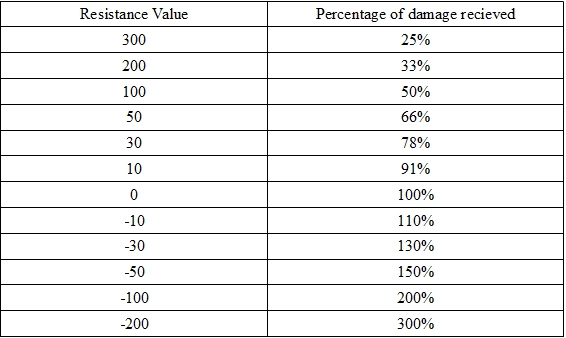
As can be seen from the table, no matter how much resistance the ship has, incoming damage will never equal zero. However, if resistance is reduced, incoming damage increases significantly.
It may give the impression that each successive unit of resistance to damage is less effective than the previous one. Yes, in terms of the resulting damage it’s correct.
The first 50 units of resistance reduce damage taken by 33% and the next 50 points (100 in total) reduce damage by a further 17% (up to 50% in total).
Some players may decide that further increasing their resistance is inefficient and it’s better to use modules increasing other parameters (such as hull strength).
But let’s look at resistance from the point of view of “ Survivability ”. By this term we mean the total amount of hull and shield strength together with damage resistance modifiers — that is, the amount of damage your ship can withstand, or, if you divide this value by the DPS value of the enemy, the time that the ship will actually survive in battle.
At the same time we will try to determine which is better: the percentage increase in hull strength or a damage resistance increase.
To do this, you need to analyse the following synthetic example:
- Let’s assume that your ship only has hull strength, and it’s at 10,000 pts.
- We have to choose what’s better to install: a module that increases hull strength by 50% or a module that increases resistance to damage by 50 pts.
Now let’s calculate the survivability of the ship, and how much it’s actually going to live, if it is being fired upon by the enemy at 1000 damage points per second.

The table shows that 1 point of resistance is equal to 1% of additional hull strength from the point of view of survival.
However, let us once again make sure that the following 50 pts. of resistance are as effective as additional 50% of hull strength.
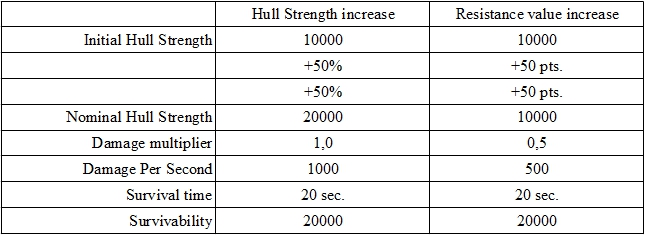
As you can see, everything checks out — 1 point of resistance is equal to 1% of additional hull strength in terms of survival.
But then the question arises: what happens if we use different modules — one to increase resistance, and the other to increase hull strength by a given percentage?
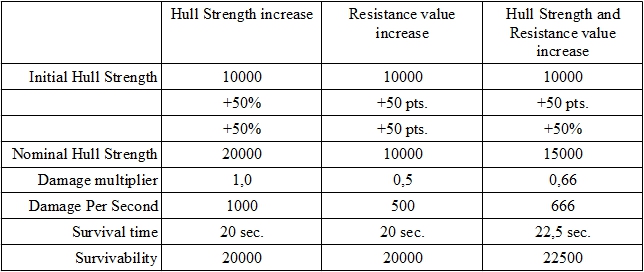
As you can see, paying attention to two areas of ship equipment is more effective than just stacking hull strength or resistance to damage.
But let’s not stop here. After all, our game is not only about improving survivability in isolated cases, but also about interaction between players of different roles. In addition to external hull repair there’s also shield regeneration (which can also be carried out externally, in addition to the standard regeneration rate).
Let’s consider two cases of hull repair:
- First case - weak recovery rate (50 points per second)
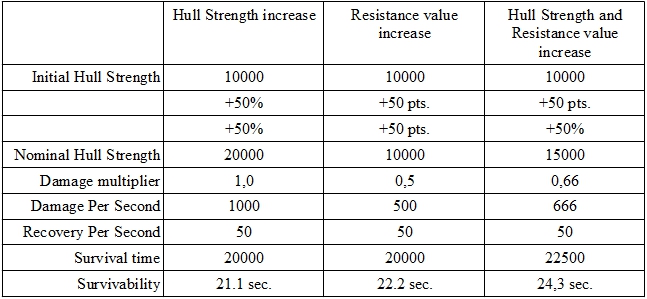
- Second case - good recovery rate (250 points per second)
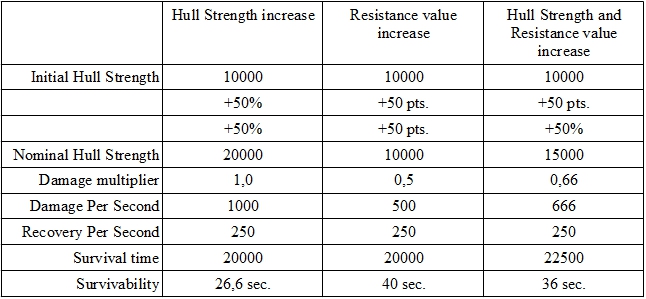
We will let you make your own conclusions here.
In addition, we would like to give the new players a few simple tips on how to improve their survivability in combat:
- If you don’t want to die from a severe blow (missiles, mines), your survivability has to be higher than the damage that would be dealt.
- A module that would temporarily increase hull strength does not exist, but as described above, the survival rate is increased by using two types of modifiers. Thus, in order to survive predictable alpha strikes, it is better to use passive hull and shield strength increase modules, but to improve your survivability under constant enemy fire, you have to remember to include temporary damage resistance amplifiers.
But for the more experienced pilots we also provide additional information associated with regeneration and interaction in combat:
As you can see, simultaneously regenerating and taking damage for which you have resistance provides greater survivability. To describe this moment let’s resort to the term “effective recovery”. By this term we understood that recoverable reserve of strength that the attacker would need to overcome in order to effectively do damage to the player’s ship. This number can also be calculated by the following formula:
Effective recovery = Basic recovery*(1+damage resistance value/100)
When simultaneously regenerating and taking damage for which you have no resistance, effective recovery can be calculated by the following formula:
Effective recovery = Basic recovery/(1-damage resistance value/100)
What’s this formula for? Let’s look at an example:
— Let’s assume that a ship has hull strength of 10,000 pts. and damage resistance of 50 pts. (Survivability = 15000), in that case, each tick of the ship hull repair of 100 pts. will be calculated using the formula: 100*(1+0.5) = 150 effective healing. Thus, to effectively cause damage, the attacker would have to deal not 100 but 150 damage points.
In addition: despite the fact that more damage resistance increases the amount of effective recovery, modules for temporary increase in resistance are “bad” helpers in the repair process: they temporarily increase survivability by the same amount, as effective recovery, so the “bonus” of made up strength will be lost together with the surplus survivability.
— Modules reducing the enemy’s resistance to damage work effectively against any number of enemy resistances, despite the large numbers hovering above enemies with negative resistances. Take 2 ships with 10,000 survivability: the first vessel’s resistance is 0 and it has 10000 hull strength, the second ship’s resistance is at 100 pts. and hull strength is at 5000. Let’s reduce their resistances by 100 and the fire a shot with 1000 damage. In the first case (100 Resistance) the ship will receive 2000 damage, in the second (0 Resistance) — 1000. In both cases, 5 shots are needed to destroy the ship.
— Modules reducing resistances also reduce the enemy’s effective recovery
— Modules increasing your damage are best used simultaneously with the resistance debuffers:
Imagine the following situation: We have 2 shots with 1000 damage and a target with 5,000 hull strength and zero resistance to damage. We can use any one shot to reduce the target’s resistance by 100 and any one shot to make it deal twice as much damage. If we do this in turns (no matter in what order), then the target will receive (1000 * 2) + (1000 * (1 - (-1))) = 4000 damage, and it will have 1000 hull strength left. If we shoot simultaneously using the two modifiers, the first shot will deal 1000 * (1 - (-1)) * 2 = 4000 damage, and the second another 1,000.
If, however, we distract ourselves from the synthetic examples with 10,000 hull strength, we have to keep in mind that ships in Star Conflict have damage resistance, not only for hulls but also for shields. And the performance of these resistances may be different. Try to experiment with them — our game gives you plenty of opportunities to modify these parameters. As this article shows, a correctly matched set of equipment can significantly increase your survivability in battle!
At this point we would like to conclude today’s blog. As always, we are looking forward to your comments!
